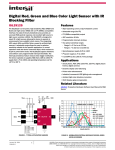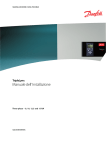Download Contents 1. Supplement to Manual Set 2. Grid Codes 3
Transcript
Contents Contents 1. Supplement to Manual Set 2 2. Grid Codes 3 3. Functionality Supporting EEG2012 (Germany) 5 4. TLX Series 6k 9 5. Parallel PV String Configuration 14 6. Miscellaneous 16 L00410591-04_02 1 1. Supplement to Manual Set 1 1. Supplement to Manual Set 1.1. Introduction The information in the enclosed manual set applies, with the addition of this supplementary information. Refer to the download area at www.danfoss.com/solar for the newest manuals. 2 L00410591-04_02 2. Grid Codes 2. Grid Codes 2 2.1. Grid Codes Select grid codes as follows: Germany New installations: • “Germany_MV” = for installations on the medium-voltage grid (medium-voltage guideline). • “Germany_LV1” = for installations up to and including 13.8 kVA connected to the lowvoltage grid (AR-N 4105). • “Germany_LV2” = for installations above 13.8 kVA connected to the low-voltage grid (AR-N 4105). • ”Germany_LV3” = for installations connected to the low-voltage grid (AR-N4105) with pre-configured Power factor = 1 Existing installations: • “VDE_0126_1_1_A1” = Exchange units in installations where “Germany” is the selected grid code. Italy • “Italy” = for installations connected to the low-voltage grid without a transformer. • “Italy-plant” = for installations connected to the low-voltage grid or medium-voltage grid with a transformer. • “Italy 6 kW” = for installations up to 6 kW connected to the low-voltage grid without an external disconnection device (SPI). Denmark New installations: • “Denmark_LV1” = for installations up to and including 11 kVA connected to the lowvoltage grid (TF 3.2.1 / AR-N 4105). • “Denmark_LV2” = for installations above 11 kVA connected to the low-voltage grid (TF 3.2.1 / AR-N 4105). • “Denmark_LV3” = for installations connected to the low-voltage grid (AR-N 4105) with preconfigured Power factor = 1 • “EN 50438-DK” = for installations with TLX / TLX Pro (TF 3.2.1 / EN 50438-DK) Existing installations: • “EN 50438-DK” = Exchange units in installations (before 01.01.2012) where “Denmark” is the selected grid code or for TLX / TLX Pro (TF 3.2.1 / EN 50438-DK). L00410591-04_02 3 2. Grid Codes 2.2. Reactive Power Standard reactive power settings are configured with the grid code. Changes to a standard grid code will generate the grid code 'custom'. 2 PF(P) The inverter will generate a variable level of reactive power depending on the output power. The relationship between reactive power and active power is entered as a setpoint curve. The setpoint curve can consist of up to 9 points with the reactive power in the range from: 0.8 under-excited to 0.8 over-excited. 150AA032.10 PF 0.80 0.85 0.90 0.95 1.00 P/Pnom 50 100 0.95 0.90 0.85 0.80 Illustration 2.1: Example of Default Setpoint Curve for Germany LV: Installations less than or equal to 13.8 kVA For some grid codes, the setpoint curve behaviour is only activated over a certain grid voltage level. Italy To ensure that sufficient current is always available to supply the required reactive power, the inverter must allocate spare capacity. In these cases, the inverter active power output is limited to: [name plate rating] x [cos(φ) required] Example: 6 kVA x 0.9 = 5.4 kW (see AC power rating table) To override this value, set reactive power settings via the web interface, at Plant level: [Setup → Grid Management] To remove this allocation of spare capacity, disable reactive power. 4 L00410591-04_02 3. Functionality Supporting EEG2012 (Germany) 3. Functionality Supporting EEG2012 (Germany) 3.1. Introduction 3 For installation in Germany, for inverters of any rating, follow this instruction carefully. This inverter complies with the requirements of Erneuerbare-Energien-Gesetz (EEG2012). The EEG2012 redefines how PV installations are designed in terms of output power and grid connection: • The requirement for remote-controlled power reduction (known as Power Level Adjustment) is extended from installations exceeding 100 kW capacity only, to apply to all installations. • Alternatively for installations of capacity up to and including 30kWp, a 70% rule can be applied. 3.2. Configuration of Power Level Adjustment Power level adjustment (PLA) is an existing feature in the inverter which is now used for smaller installations. For further information about PLA, refer to the Reference Manual and the Web Server User Manual. 3.3. Configuration of 70% Rule The EEG2012 states that the power at the point of common coupling (PCC) must be limited to transfer of max. 70% of installed nominal PV module power [kWp]. This limit is referred to as “70% of installed PV power”. Thus it is possible to take self-consumed power into account. It is important that the self-consumption can be guaranteed. This means that the real value of selfconsumption must under no circumstances fall below the value used in the calculation. Limit the power at PCC to 70% of the installed nominal PV module power [kWp] Note: When an incorrect value of “70% of installed PV power” is entered, serious consequences can result. In the event that the 70% limit is exceeded, the DNO can demand disconnection of the installation from grid. 3.3.1. Example of Calculation This is an example of how to calculate “Absolute value”, used in the section How to Configure a Limit for the Output Power. Data: • 12 kWp installed power • Inverter rating 10 kW • 1 kW guaranteed self-consumption L00410591-04_02 5 3. Functionality Supporting EEG2012 (Germany) Calculation of ”70% of installed PV power”: • Absolute value = (Installed peak PV power x 0.7)[kW] + Self-consumption [kW] = (12 kWp x 0.7 kW/kWp) + 1 kW = 8.75 kW+1 kW 3 = 9.75 kW = 9750 W • The entry for “Absolute value” is 9750. 3.3.2. How to Configure a Limit for the Output Power (Inverter Level) Note: Access at security level 1 or higher is required, in order to configure PLA and output power limits. Configuration via display interface: 1. In the inverter display, go to [Setup → Grid management → Output power] 2. Follow the steps in the section Configuration via Display Interface (Inverter Level). 3. To replicate to the other inverters in the network, go to [Setup → Service → Replicate]. Configuration via the web server or service interface (TLX Pro and TLX Pro+ only): 1. Go to [Inverter → Setup → Grid management → Output power] 2. Follow the steps in the section Configuration via the Web Server or Service Interface (Inverter Level). 3. To replicate to the other inverters in the network, go to [Inverter → Setup → Service → Replicate] 3.3.3. Configuration via Display Interface (Inverter Level) There are four methods to limit the output power of the inverter: 1. Limit output power by external input (default setting). 2. Absolute value [W]. 3. Percentage based on total installed PV power *(peak PV power connected to the inverter). 4. Percentage based on nominal AC output power **(kW – nominal AC output power of the inverter). To set an absolute value: 1. In the inverter display, go to [Setup → Grid management → Output power → Lim type]. 2. Choose “Absolute value”. 3. Choose “Output power limit” and enter the applicable output limit of the inverter (for example 7000 W). 4. Click “Save”. The inverter output power will now be limited to an absolute value. For example: 7 kW. 6 L00410591-04_02 3. Functionality Supporting EEG2012 (Germany) To set a percentage based on total installed PV power: 1. In the inverter display, go to [Setup → Grid management → Output power → Lim type]. 2. Choose “Pct based on PV” . 3. Choose “Output power limit” and enter the applicable output limit of the inverter (for example 70%). 4. Click “Save”. 3 The inverter output power will now be limited to a percentage value of the total installed PV power. For example: When the installed power is 18 kWp, and the output power of the inverter is limited to 70%, then output power = 18x0.7 = 12.6 kW. To set a percentage based on nominal AC output power: 1. In the inverter display, go to [Setup → Grid management → Output power → Lim type]. 2. Choose “Pct based on ACP” in the Lim. Type menu. 3. Choose “Output power limit” and enter the applicable output limit of the inverter (for example 70%). 4. Click “Save”. The inverter output power will now be limited to a percentage of the nominal AC output power. For example: For a 12.5 kW inverter when the output power is limited to 70%, then output power = 12.5x0.7 = 8.75 kW. 3.3.4. Configuration via Web Server or Service Interface (Inverter Level) There are four methods to limit the output power of the inverter: 1. Limit output power by external input (default setting). 2. Absolute value [W]. 3. Percentage based on total installed PV power (peak PV power connected to the inverter). 4. Percentage based on nominal AC output power (kW – nominal AC output power of the inverter). To set an absolute value: 1. Go to [Inverter → Setup → Grid management → Output power]. 2. Click on “Absolute value”. 3. Type the applicable output limit of the inverter (for example 7000 W). 4. Click “Save”. The inverter output power will now be limited to an absolute value. For example: 7 kW. To set a percentage based on total installed PV power: 1. Go to [Inverter → Setup → Grid management → Output power]. 2. Click on “Percentage based on total installed PV power”. L00410591-04_02 7 3. Functionality Supporting EEG2012 (Germany) 3. Type the applicable output limit of the inverter (for example 70%). 4. Click “Save”. For example: When the installed power is 18 kWp, and the output power of the inverter is limited to 70%, then output power = 18 x 0.7 = 12.6 kW. 3 To set a percentage based on nominal AC output power: 1. Go to [Inverter → Setup → Grid management → Output power]. 2. Click on “Percentage based on nominal AC output power”. 3. Type the applicable output limit of the inverter (for example 70%). 4. Click “Save”. The inverter output power will now be limited to a percentage of the nominal AC output power. For example: For a 12.5 kW inverter when the output power is limited to 70%, then output power = 12.5 x 0.7 = 8.75 kW. 3.4. Verification To verify that the change in configuration has been implemented, access at security level 0 or higher is required. 3.4.1. Display Interface (Inverter Level) To view the output power limit of the inverter • Go to [Status → Grid management → Output power limit] • The value of the limit is displayed as an absolute value or percentage, depending on the chosen setting. 3.4.2. Web Server or Service Interface (Plant Level) To view the power level adjustment setting of the plant • Go to [Plant → View → Overview]. • The value for power level adjustment of the plant is displayed as a percentage. 3.4.3. Web Server or Service Interface (Inverter Level) To view the overall output power limit of the inverter • Go to [Inverter → View → Overview]. • The value for power level adjustment of the inverter is displayed as a percentage. To view the output power limit of the inverter 8 • Go to [Inverter → Status → Grid management → Output power limit] • The value of the power limit is displayed as an absolute value or percentage, depending on the chosen settings. L00410591-04_02 4. TLX Series 6k 4. TLX Series 6k 4.1. Functionality Overview 4.1.1. TLX Series 6k Unless otherwise specified, manual data and instructions for the Danfoss TLX+ 10k and TLX Pro+ 10k inverters apply equally to the Danfoss TLX+ 6k and TLX Pro+ 6k inverters. 4 Variant User interface Ancillary services Local Web Server Power Level Adjustment, Ride Through Fault Ride Through Primary Frequency Control Reactive Power TLX+ 6k ✓ ✓ ✓ ✓ TLX Pro+ 6k ✓ ✓ ✓ ✓ ✓ Table 4.1: Functionality Overview 4.1.2. Derating See also the TLX Reference Manual, Chapter 3. TLX Series 6k PV current, per input 12 A (+ 2%) Grid current, per phase 9 A (+ 2%) Grid power, total 6000 W (+ 3%) To avoid unintentional derating due to measurement inaccuracy, the values in brackets are added to the limits. Table 4.2: Derating Limits 4.1.3. Excessive Grid Power See also the TLX Reference Manual, Chapter 3. The factory settings include a preset PV power capacity per input, which is 6 kW per PV input. To avoid exceeding the maximum PV power allowed, the inverter will reduce the value evenly; hence: Variant TLX+ 6k TLX Pro+ 6k No. of PV Inputs Power Limit per PV input 2 6.0 kW Table 4.3: DC Power Limits 4.1.4. Efficiency See also the TLX Reference Manual, Chapter 3. L00410591-04_02 9 η [%] 150AA038.10 4. TLX Series 6k 100 98 96 94 4 92 U DC [V] 420V 700V 800V 90 0 2000 4000 6000 P[W] Illustration 4.1: Danfoss TLX+ 6k and Danfoss TLX Pro+ 6k: Efficiency [%] versus AC Power [kW] TLX Series 6k TPPV/ UPV 5% 10% 20% 30% 50% 100% EU 420 V 700 V 800 V 88.2% 91.8% 93.6% 94.9% 96.4% 96.7% 95.4% 89.6% 92.8% 94.4% 95.8% 97.6% 97.8% 96.5% 87.5% 91.4% 94.5% 96.0% 97.4% 97.9% 96.3% Table 4.4: Efficiencies, Danfoss TLX+ 6k and Danfoss TLX Pro+ 6k 4.1.5. Cable Requirements See also the TLX Reference Manual, Chapter 5. Cable Requirement Maximum inverter current Recommended fuse type gL/gG TLX Series 6k 9A 13 A 150AA044.10 Table 4.5: Mains Circuit Specifications [%] 2 2.5 mm 2 4 mm 2 1.5 6 mm 2 10 mm 2 1 0.5 0 0 20 40 60 Illustration 4.2: TLX Pro+ 6k Cable Losses [%] versus Cable Length [m] 10 L00410591-04_02 80 [m] 4. TLX Series 6k 150AA049.10 4.1.6. Grid Impedance ZG [ ] 3 6 kW 2.5 8 kW 10 kW 2 12.5 kW 15 kW 4 1.5 1 0.5 0 230 235 240 245 250 255 UAC [V] Illustration 4.3: Grid Impedance: Maximum Permissible Grid Impedance [Ohm] versus No-load Grid Voltage [V] 4.1.7. Nominal Operating Area See also the TLX Reference Manual, Chapter 5. The nominal/maximum input specification per PV input and total are given in the table below: Parameter Number of inputs Nominal / maximum PV power per input Maximum input voltage, open circuit Maximum input current Nominal / maximum PV power, total TLX Series 6k 2 6000 W 1000 V 12 A 6200 W Table 4.6: PV Operating Conditions L00410591-04_02 11 4. TLX Series 6k 12 4 250, 12.0 1 150AA050.10 3 I PV [A] 500, 12.0 11 10 600, 10.0 9 700, 8.6 8 800, 7.5 7 6 4 5 5 4 3 2 1 2 100 200 300 400 500 600 700 800 900 1000, 0.0 1000 U PV [V] P PV [W] 6000 800,6000 500,6000 5500 5000 4500 4000 3500 250,3120 3000 250,3000 2500 6 2000 1500 1000 500 100 200 300 400 500 600 700 800 900 1000 U PV [V] Illustration 4.4: MPP Area, TLX+ 6k and TLX Pro+ 6k Legend 1 2 3 4 5 6 Maximum short-circuit current Maximum open-circuit voltage Constant current Constant power MPP area MPP area nominal power 4.1.8. Recommendations and Goals when Dimensioning - Optimising PV Power See also the TLX Reference Manual, Chapter 5. The ratio between installed PV power at STC (PSTC) and nominal inverter power (PNOM), the socalled PV-to-grid ratio KPV-AC, is used to evaluate the sizing of the inverter. To reach a maximum Performance Ratio with a cost-efficient solution, the following upper limits should not be exceeded. 12 L00410591-04_02 4. TLX Series 6k System Type Max KPV-AC Tracker systems Fixed systems with optimal conditions: Close to ideal orientation (between SW and SE) and inclination (greater than 10°) Fixed systems with semi-optimal conditions: Orientation or inclination exceeds the above mentioned limits. 1.05 Corresponding power for TLX Series 6k 6.3 kWp 1.12 6.7 kWp 1.18 7.1 kWp Table 4.7: Optimisation of PV Configuration 4.1.9. Technical Specifications 4 See also the TLX Reference Manual, Chapter 12. AC Nomenclature 1) Pac,r Vac,r Vac, min - Vac, max Iacmax cosphiac,r Parameter TLX Series 6k Max./Nom. power AC Reactive power range Rated output voltage AC voltage range (P-N) Nominal current AC Max. current AC AC current distortion (THD%) Power factor at 100% load 6000 W 0-3.6 kVA 3 x 230 V 3 x 230 V ± 20% 3x9A 3x9A < 4% > 0.99 0.8 over-excited 0.8 under-excited 10 W <5W 50 Hz 50 ± 5 Hz 6200 W 7100 Wp 700 V Controlled power factor range fr fmin - fmax DC Vdc,r Vmppmin Vmppmax Vdcmax Vdcstart Vdcmin Idcmax Efficiency “Connecting” power loss Night-time power loss (off grid) Grid frequency Grid frequency range Nominal power DC Max. recommended PV power at STC Nominal voltage DC MPP voltage - nominal power 3) MPP efficiency Max. DC voltage Turn on voltage DC Turn off voltage DC Max. current DC Max. short circuit current DC at STC Min. on grid power Max. efficiency Euro efficiency, V at dc,r 2) 260-800 V 99.9% 1000 V 250 V 250 V 2 x 12 A 2 x 12 A 20 W 97.8% 96.5% Table 4.8: Technical Specifications 1) According to EN 50524:2009. 2) For fixed systems with semi-optimal conditions. 3) At identical input voltages. At non-identical input voltages, Vmppmin can be as low as 250 V depending on total input power. L00410591-04_02 13 5. Parallel PV String Configuration 5. Parallel PV String Configuration 5.1. Parallel PV String Configuration 1 5 12A 12A 12A Cabling Inverter PV module 2 12A 20A 12A 20A 12A 20A 12A 20A 12A 20A 12A 20A 12A 20A 12A 12A 12A 1 12A 12A 12A 30A 1 12A 12A 12A 12A 20A 12A 20A 7A 7A 7A 7A 3 Illustration 5.1: Correct Parallel Connection Legend 1 Parallel jumper 2 Parallel connection, 3 inputs 3 Parallel connection, 2 inputs 14 L00410591-04_02 150AA026.11 For parallel PV string configuration, always use the internal parallel jumper, together with an external parallel coupling. 2 Cabling Inverter 1 12A 12A 12A 2 7A 20A 12A 7A 12A 20A 12A 20A 7A 7A 1 12A 12A 12A PV module 150AA027.11 5. Parallel PV String Configuration 3 12A 20A 12A 20A 12A 20A 5 30A 4 12A 12A 12A 12A 20A 12A 20A 12A 20A 30A Illustration 5.2: Incorrect Parallel Connection Legend 1 Parallel jumper 2 Parallel connection, 1 input. Current in first input is exceeded, thus overloading cable and PV load switch. 3 Parallel connection missing. All PV power feeds into one input, thus risking overload of PV connector, cable and PV load switch. 4 Parallel jumper missing, thus risking overload of PV connector, cable and PV load switch in the event of inverter failure. L00410591-04_02 15 6. Miscellaneous 6. Miscellaneous 6.1. CLX Portal 6.1.1. How to Register the TLX Pro+ Inverter on the CLX Portal For instructions on how to register the TLX Pro+ inverter on the CLX Portal, go to: www.danfoss.com/solar → [Products → CLX Portal → How to register]. 6.2. UTE Requirements in France For installation in France, apply warning label to front of inverter. 6 Illustration 6.1: Position of Warning Label 6.3. Residual-current Device (RCD) The design of TLX leads to a DC leakage current exceeding 6 mA during single fault conditions. Consult local guidelines to choose the correct RCD type, dependent on: - grid type - whether the RCD is used to ensure automatic disconnection - whether the RCD is used to provide additional safety Note: For low-voltage grids in Denmark, an RCD Type B is required according to the local guidelines. 16 L00410591-04_02 6. Miscellaneous 6.4. Fans The TLX Series inverters are designed with two fans. 6 Illustration 6.2: Mechanical Overview of the Inverter Item number 1 2 3 4 5 6 7 8 9 10 11 12 13 14 15 16 17 18 19 20 21 Part Name Wall Plate Condensing Cover Die Cast Aluminium-Heatsink PV load switch Base plate Fan grill, 80 mm x 80 mm Fan, 80 mm x 80 mm x 38 mm Cover for 80 mm x 80 mm fan hole Aux. board GSM modem (optional) Communication board Display Front cover Gasket for front cover Control board Fan, 40 mm x 40 mm x 15 mm Mounting plate for PCB Power board Coil box Top plate GSM antenna (optional) Table 6.1: Inverter Components L00410591-04_02 17 6. Miscellaneous 6.5. AC Power Rating See also the TLX Reference Manual, Chapter 12. Parameter S_max S_nom P_nom P_nom P_nom at cos(φ) 1 0.95 0.90 TLX Series 6k 8k 10k 12.5k 15k 6180 VA 8240 VA 10300 VA 12875 VA 15450 VA 6000 VA 8000 VA 10000 VA 12500 VA 15000 VA 6000 W 8000 W 10000 W 12500 W 15000 W 5748 W 7664 W 9580 W 11975 W 14370 W 5400 W 7200 W 9000 W 11250 W 13500 W Table 6.2: AC Power Rating 6 18 L00410591-04_02







































